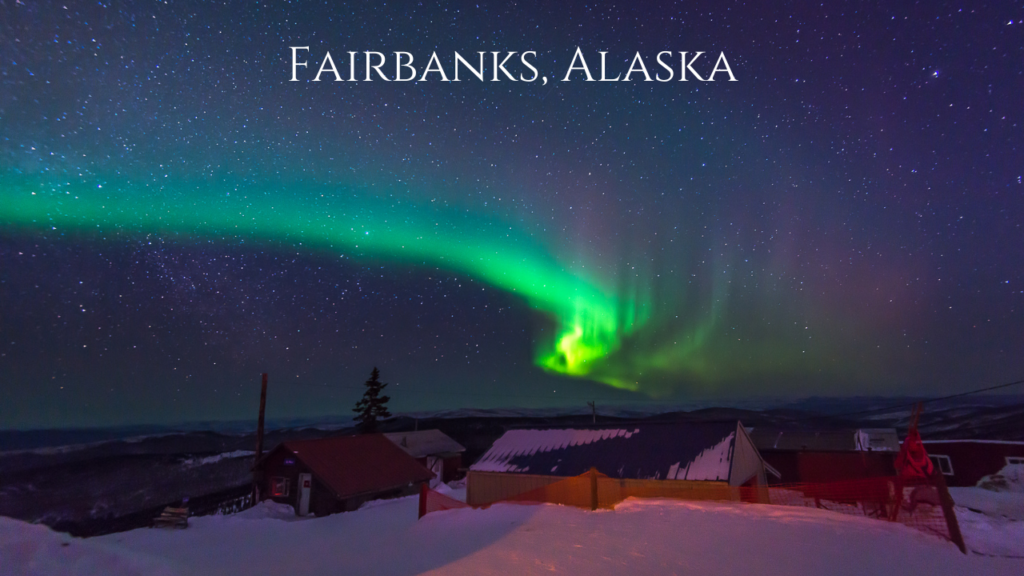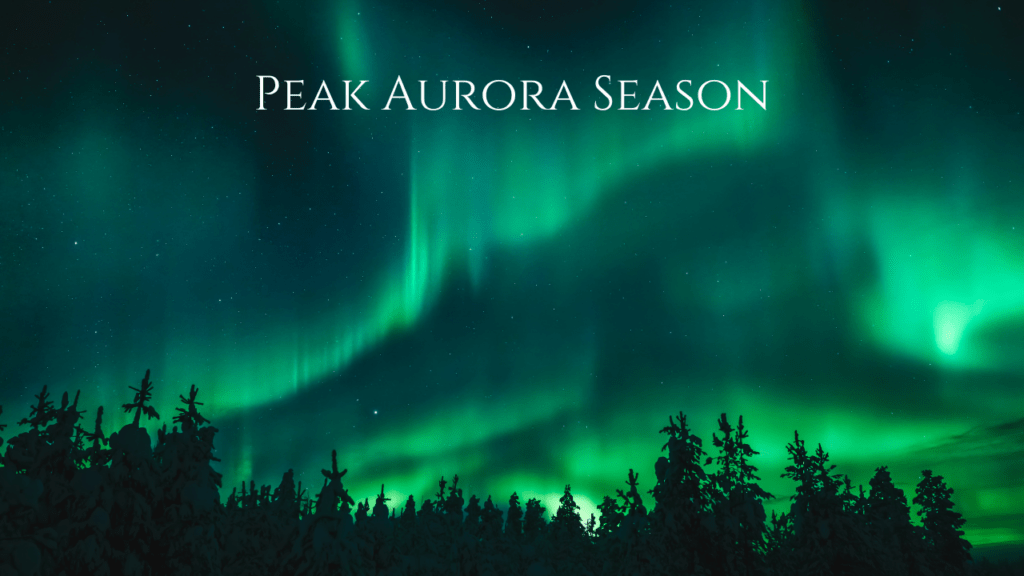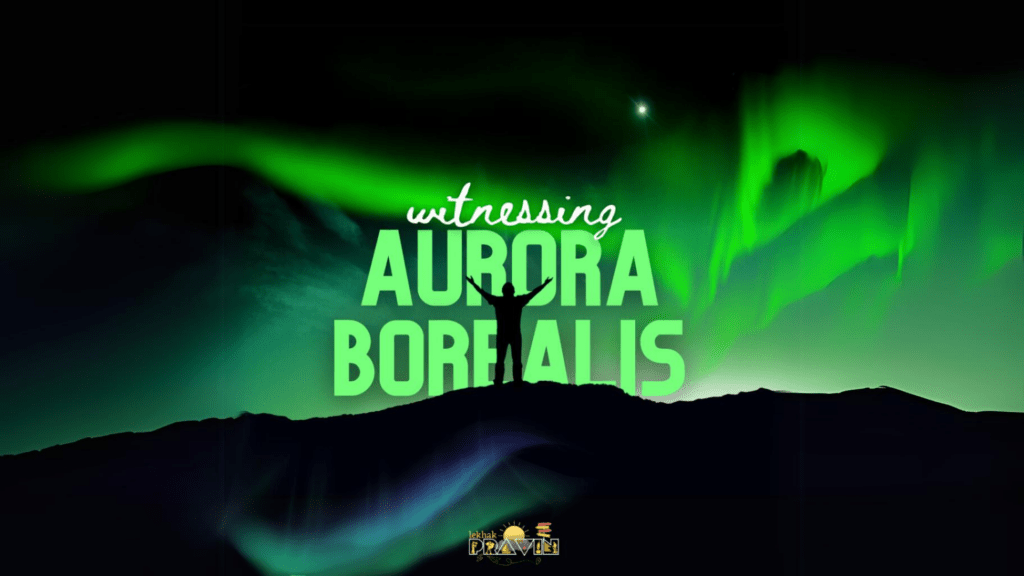The Aurora Borealis is a spectacular natural light display that appears in the night sky, usually in the polar regions around the Arctic. The lights are caused by collisions between electrically charged particles from the sun entering the Earth’s atmosphere. The Aurora Borealis are also commonly referred to as the ‘Northern Lights.’
Where to See the Northern Lights: Top Destinations for Aurora Viewing
Are you a fan of the Aurora Borealis and want to experience them in the best possible way? Below you will be surfing through some of the best destinations for Aurora Borealis viewing to make your experience worth it:
Fairbanks, Alaska: The Heart of the Auroral Oval
Fairbanks, Alaska is located directly beneath the auroral oval, leading to frequent northern lights sightings. The aurora season runs from late August to late April, with clear nights and low light pollution making for ideal viewing conditions. During the day, visitors can enjoy activities like dog sledding and snowmobiling.

- Located directly beneath the auroral oval at 64° N latitude, with frequent sightings
- Aurora season runs from August 21 to April 21, with clear nights and low light pollution
- Fairbanks experiences aurora activity an average of 243 nights per year
- Popular daytime activities include dog sledding, snowmobiling, and hot springs
Tromsø, Norway: The Paris of the North
Tromsø, Norway sits above the Arctic Circle in the center of the northern lights oval. The city offers a mix of vibrant urban life and stunning natural fjord landscapes. Peak viewing is from September to early April, with the most activity around the equinoxes. Mount Storsteinen provides panoramic views over the city and is a great spot to see the auroras.

- Situated at 69° N in the center of the northern lights oval
- Combines vibrant city life with stunning fjord landscapes
- Aurora viewing from September to early April, peaking around the equinoxes
- Mount Storsteinen offers panoramic views over the city and is a great spot for aurora photography
Lapland, Finland: A Winter Wonderland
Finnish Lapland is known for its aurora-viewing glass igloos and luxury suites. The northern lights appear roughly 200 nights a year here. Top locations include Rovaniemi, Inari, Ivalo, and the ski resorts of Levi and Ylläs. Visitors can combine aurora-chasing with Sámi culture experiences, reindeer and husky safaris.

- Known for unique accommodations like glass igloos and luxury aurora suites
- Northern lights visible roughly 200 nights per year
- Top locations include Rovaniemi (the official hometown of Santa Claus), Inari, Ivalo, and the ski resorts of Levi and Ylläs
- Combine aurora chasing with Sámi cultural experiences, reindeer/husky safaris, and visits to Arctic ice hotels
Iceland: Land of Fire and Ice
Iceland’s location between 60-75°N is ideal for northern lights viewing. The aurora season runs from late August to April, peaking near the equinoxes. Popular spots include Thingvellir National Park, Jökulsárlón Glacier Lagoon, and the Snæfellsnes Peninsula. Renting a car allows for self-drive aurora hunting, or visitors can join a guided tour to secret viewing locations.

- Ideal latitude between 64-66° N, with aurora season from late August to April
- Popular viewing spots include Thingvellir National Park, Jökulsárlón Glacier Lagoon, and the Snæfellsnes Peninsula
- Many options for guided aurora tours or independent rental car exploration
- Other highlights include glacier hikes, ice caves, waterfalls, and geothermal spas
Yellowknife, Canada: The Aurora Capital of North America
Yellowknife, the capital of Canada’s Northwest Territories, boasts the best aurora viewing odds in North America. The northern lights are visible up to 240 nights per year here, from late August to early April. The city’s flat geography and extremely cold, dry climate provide optimal conditions. Indigenous-led aurora tours offer a deeper cultural connection to the lights.

- Flat geography, extremely cold/dry climate, and location at 62° N provide optimal viewing conditions
- Auroras visible up to 240 nights per year, from late August to early April
- Great infrastructure for aurora tourism, with many hotel and tour options
- Indigenous cultural experiences offer a deeper connection to the lights
To maximize your chances of seeing the northern lights, plan to spend at least 3 nights in one of these destinations during the peak viewing season from September to March. Stay up late, get away from city lights, and be patient – the aurora is a natural phenomenon and sightings are never guaranteed, but the experience is truly unforgettable when they do appear.
Combining aurora-chasing with other bucket list winter activities like dog sledding, staying in a glass igloo, and tasting Arctic flavors will make for the adventure of a lifetime under the magical dancing skies.
Best Time to See the Northern Lights: When to Go
The best time to catch the Aurora Borealis is during the Aurora Season, which runs from late August to early April. Dark, clear skies are crucial, and this period has the longest, darkest nights near the Arctic Circle.
Top Times to See the Aurora:
- Equinoxes (September and March): These months see higher solar activity, which means stronger auroras.
- Mid-November through January: The nights are longest during this time, offering extended hours of darkness.
- February to Early April: While the skies are still dark, the weather tends to be slightly milder.
For an optimal northern lights viewing experience, it’s recommended to plan a trip around these months.
The northern lights are typically visible from late August/early September to early/mid-April in areas near the Arctic Circle like Alaska, Iceland, Northern Canada, and Scandinavia. This period from fall to spring is known as the “Aurora Season” because the nights are dark enough to see the lights.

Within the Aurora Season, some of the best times are:
- Around the fall and spring equinoxes in September and March. The equinox periods often coincide with higher levels of solar activity and geomagnetic storms that intensify the auroras. Late September is considered one of the peak times.
- Mid-November through January have the longest and darkest nights, especially near the winter solstice in December. During this period, the skies are dark from early afternoon until late morning, maximizing the window of opportunity to spot the lights. January is often cited as the single best month.
- February through early April offer dark skies combined with somewhat milder temperatures compared to mid-winter. The spring equinox in March also corresponds with strong auroral activity.
September to March: Peak Aurora Season
The peak season for viewing the northern lights (aurora borealis) spans from September through March. This period, known as the “Aurora Season”, coincides with the darker nights in the fall and winter months in areas near the Arctic Circle like Alaska, Iceland, Northern Canada, and Scandinavia.
Within this peak viewing window, some of the best sub-periods are:
- Around the fall and spring equinoxes in September and March. Geomagnetic activity tends to be higher in the weeks around the equinoxes, leading to more frequent and intense auroral displays. Late September is considered one of the very best times.
- Mid-November through January have the longest and darkest nights, especially near the winter solstice in December. The extended hours of darkness provide a bigger window of opportunity each night to potentially see the northern lights.
- February through early April offer dark skies combined with somewhat milder temperatures compared to the heart of winter. The spring equinox in March also corresponds with heightened auroral activity.
Solar Maximum: The Best Time to See Intense Northern Lights Displays
If you want to see the most intense Northern Lights displays, aim for 2024-2026, when the solar cycle reaches its peak. Known as solar maximum, this period increases the frequency and intensity of auroras. Even areas that don’t usually see the lights, like Scotland or the northern US, may get a glimpse.
The sun goes through an approximately 11-year solar cycle, marked by the rise and fall of solar activity and sunspots. The peak of this cycle, known as the solar maximum, corresponds with a higher likelihood of intense northern lights displays.
The upcoming solar maximum is predicted to occur between late 2024 and early 2026, with some of the strongest activity expected in 2025. During these solar max years, several factors align to create optimal aurora viewing conditions:
- Increased solar flares and coronal mass ejections (CMEs) from the sun send more charged particles toward Earth, fueling geomagnetic storms and auroras.
- The auroral ovals expand during solar maximums, making the northern lights visible at lower latitudes than usual. However, the best locations in the far north like Alaska, Iceland, and Lapland will still have the most dramatic displays.
- Statistically, Earth experiences twice as many geomagnetically active days in solar maximum years compared to solar minimum years. On average, there are 6 nights with very high auroral activity in March during solar max compared to just 3 in December of a solar min year.
So in summary, the absolute peak times are around the equinoxes in late September and late March, followed by the winter months from November through February with the longest nights. But any time between September and April offers a good chance, as long as the weather cooperates with clear, dark skies.
Tips for an Unforgettable Northern Lights Experience
Here are some tips for an unforgettable northern lights experience:
Choose a Dark, Clear Location Away from City Lights
To maximize your chances of seeing the northern lights, get away from the light pollution of cities and towns. The darker the sky, the more visible the aurora will be. Check cloud cover forecasts and be willing to drive to areas with clearer skies if needed.
Stay Up Late and Be Patient
The most active and vivid aurora displays often occur late at night, typically between 10 PM and 2 AM. It’s a natural phenomenon, so sightings are never guaranteed, but it’s worth staying up for the chance to see the magical lights.
Dress warmly in layers so you can comfortably wait outside in freezing temperatures for extended periods. Hand and toe warmers can help a lot. Bring a thermos of hot drinks and snacks to help pass the time.
Capture the Magic with Aurora Photography
With a bit of preparation, you can capture stunning images of the northern lights to remember your experience. Use these camera settings for optimal aurora photography:
- Sturdy tripod to keep the camera still during long exposures
- Wide angle lens with a fast aperture around f/2.8-f/4
- Set your lens to manual focus at infinity
- ISO between 800-3200 (higher ISO for faster-moving auroras)
- Shutter speed between 5-25 seconds to capture the motion of the lights
- Shoot in RAW format for maximum editing flexibility later
- Include an interesting foreground like trees, cabins, or people for scale
Combine with Other Arctic Adventures
Make the most of your northern lights trip by combining it with other bucket list winter activities. Options include:
- Dog sledding – mush a team of huskies across snowy landscapes during the day
- Reindeer sledding – visit a Sámi reindeer farm and glide through the wilderness
- Snowmobiling – cover more ground to chase the auroras or explore ice caves
- Skiing/snowshoeing – cross-country ski or snowshoe through pristine forests
- Ice fishing – drill a hole in a frozen lake and catch your own supper
- Sámi cultural experiences – meet indigenous reindeer herders and learn about their traditions
- Whale watching safaris – spot orcas, humpbacks and more in Norway’s fjords
- Ice floating and saunas – take a dip in a frozen lake before warming up in a wood-fired sauna
Book a Tour or Stay in a Unique Accommodation
Many companies in the aurora zone offer guided northern lights tours. The guides have expert knowledge on weather conditions and the best viewing spots. They’ll provide warm clothing and transport you to locations far from city lights to maximize your chances of seeing the aurora.
For a truly immersive experience, stay in a unique accommodation like a glass igloo where you can watch the northern lights dance overhead from the comfort of your bed. Or spend a night in an ice hotel sculpted entirely from snow and ice. Wilderness lodges are another great option, placing you right in prime aurora viewing territory.
With solar activity near its 11-year peak, the coming years are an ideal time to witness the northern lights in all their vivid glory. By following these tips and booking a winter trip to the auroral zone, you’re in for an unforgettable adventure under the arctic sky. Stay warm, be patient, and get ready to be awestruck by the ethereal beauty of the aurora borealis.
Key Facts About The Aurora Borealis – Northern Lights

Listed below are some of the major facts about the Aurora Borealis and once you know these things, you are surely going to fall in love with these natural sightings. Here’s some information about the Northern Lights:
- The name comes from Aurora, the Roman goddess of dawn, and Boreas, the Greek god of the north wind.
- Auroras occur in both the northern hemisphere (aurora borealis) and southern hemisphere (Aurora Australis). The northern lights are much more well known since there are more populated areas in the far north compared to the far south.
- Auroral displays appear in many colors, although pale green and pink are most common. Shades of red, yellow, green, blue, and violet have been reported. The color depends on which gas molecules are being struck by the solar particles and the altitude of the collision.
- Oxygen molecules cause the most common green and red auroras, while nitrogen produces the rare blue and purple colors.
- Auroras usually occur 60-150 miles above Earth’s surface, in the ionosphere layer of the upper atmosphere.
- The best places to see the northern lights are in the “auroral zone” which is typically 3-6 degrees from the magnetic poles, between 60-75 degrees north latitude. This includes northern Canada, Alaska, Greenland, Iceland, northern Scandinavia, and northern Russia.
- Late August through April is the best time to see the lights, with peak activity around the fall and spring equinoxes in September/October and March/April.
- During the peak of the 11-year solar cycle, known as solar maximum, auroral activity is heightened. The next solar maximum is predicted for 2024-2026, making the coming years an excellent time to see the northern lights.
Understanding the Science Behind the Aurora Borealis
Understanding the science behind the Aurora Borealis can make witnessing this natural phenomenon even more magical. Whether you are in the northern or southern hemisphere, the experience is truly unforgettable.
What Causes the Northern Lights?
The Northern Lights, also known as the Aurora Borealis, are a natural light show in the sky, mainly seen in high-latitude regions around the Arctic and Antarctic. These lights happen when charged particles from the sun hit the Earth’s atmosphere. The sun constantly sends out particles and energy, known as solar wind. When this solar wind reaches Earth, it interacts with our planet’s magnetic field.
The Earth’s magnetic field directs these particles towards the poles. When the particles collide with gases in the atmosphere, they release energy in the form of light. This is what we see as the Northern Lights. Different gases produce different colors, making the sky light up in shades of green, pink, red, and more.
Colors of the Aurora and What They Mean
The colors of the Aurora Borealis come from different gases in the Earth’s atmosphere:
- Green: This is the most common color and is caused by oxygen molecules located about 60 miles above the earth.
- Red: This is a rare color for the aurora and is produced by high-altitude oxygen, at heights of up to 200 miles.
- Purple and Blue: These colors are caused by nitrogen. Blue lights appear at lower altitudes, while purple lights are seen at higher altitudes.
Each color tells us about the type of gas and the altitude at which the aurora is occurring.
Differences Between the Northern and Southern Lights
The Northern Lights (Aurora Borealis) and the Southern Lights (Aurora Australis) are essentially the same phenomenon but occur in different hemispheres.
- Location: The Northern Lights happen near the North Pole, while the Southern Lights occur near the South Pole.
- Viewing Areas: The Northern Lights can be seen from places like Alaska, Canada, Norway, and Sweden. The Southern Lights are visible from Antarctica, New Zealand, and the southern parts of Australia.
The lights are caused by the same solar winds interacting with Earth’s magnetic field, just in different locations. The colors and patterns can be similar, but where you see them depends on where you are on the planet.
Myths and Legends of the Northern Lights
Here is an overview of the myths and legends surrounding the northern lights, also known as the aurora borealis, across various cultures:
Norse Mythology Related To Northern Lights
In Norse mythology, the northern lights held great significance. Some legends suggested that the lights were reflections or a glow from the shields and armor of the Valkyries – female warriors who chose who may die in battle and who may live to fight another day.
The aurora was also believed to be the “Bifrost Bridge” – a glowing, pulsating arch that led fallen warriors to their final resting place in Valhalla. Seeing the lights was considered a good omen that fallen warriors were being guided to the afterlife by the Valkyries.
North American Beliefs About Aurora Borealis
Many North American indigenous tribes had their own explanations for the aurora. The Cree Indians believed the northern lights were the spirits of the departed trying to communicate with loved ones still on Earth.
For the Algonquin people, the lights were from a fire built by their creator Nanahbozho to remind them that he was watching over them. On remote Nunavik Island, tales described the aurora as walrus spirits playing ball with a human skull.
Finnish Folklore About Northern Lights
In Finland, a poetic myth held that the lights were created by the firefox, a mythical creature that sprinted across the snow so quickly that sparks flew up from its tail and ignited the night sky. The Finnish word for the northern lights, “revontulet”, translates literally as “fire fox”.
Greenlandic and Sami Beliefs Related To Aurora Borealis
In Greenland, the lights were sadly linked to stillborn babies or those killed at birth, with the aurora considered to be their souls dancing across the sky.
The Sami people of northern Scandinavia had mixed views. Some saw the lights as souls of the departed, and avoided interacting with them for fear of being abducted. Others believed the lights were caused by whales ejecting water spume into the air.
Greek and Roman Mythology about Northern Lights
The ancient Greeks and Romans associated the aurora with their goddess of the dawn, Aurora. The Greeks believed she raced across the morning sky in her colorful chariot, alerting her siblings Helios (the sun) and Seline (the moon) to the start of a new day.
Why were Auroras Considered a Bad Omen in Medieval Times?
In medieval times, red auroras were often seen as omens of war, bloodshed, and disaster looming on the horizon. Sightings in 1789 across Europe were linked to the French Revolution.
However, some cultures took a more positive view. In Sweden, the lights were seen as a gift from benevolent gods and an indicator of good news to come, like a bountiful harvest or large catches of fish.
These diverse myths and legends reflect the shared awe and wonder the aurora inspired in our ancestors as they tried to make sense of the dancing lights in the sky. While we now understand the scientific origins of the northern lights, their ethereal beauty continues to enchant and inspire people around the world to this day, evoking a rich mythological and cultural heritage.
Wrapping Up: Plan Your Best Northern Lights Experience
The Aurora Borealis is a once-in-a-lifetime experience that offers both beauty and wonder. From choosing the right time and location to perfecting your photography skills, you can make the most of your northern lights viewing experience. Be sure to plan around Aurora Season (September to March) and head to one of the top northern lights destinations for the best chance of seeing these magical displays. Ready to witness the incredible dance of lights? Start planning your trip today!




